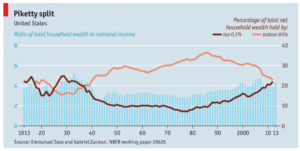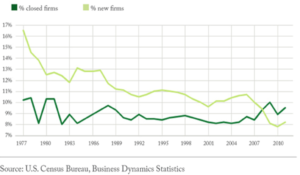
The View:
From a big picture economic perspective, we can’t wait any longer to build democratic capitalism. The Federal Reserve has lowered interest rates almost to zero since 2008, which has fueled the stock market, helped corporations borrow money at cheap rates, and allowed them to do stock buybacks to manipulate the stock price – benefiting the Elite. The Middle Class continues to lose ground with percentage of net household wealth at its lowest point last seen in 1941!. Recent Gallup Poll figures show the real unemployment rate (including those that want to work ad can’t or have dropped out of looking for work) at 9.7 %. Job automation and virtualization marches on, cars may drive themselves – reducing the need for taxi drivers, factories continue automation, the Internet provides access to low cost workers and contracted skill sets, and virtualization means fewer face to face contacts (reducing the number of jobs in the hospitality industry for example). New business formations have dramatically dropped a key engine of job growth versus major corporations.
What labor model can provide us insight? The German labor policy supports worker councils in partnership with management, short term hours (meaning when there is a recession all workers reduce their hours and are still employed), child care is available to help mother’s balance work-family life, and summer 4 week vacations support family life. New high value jobs are created, and Germany has a net export economy (more goods and services are exported than imported). During the 2009 recession unemployment rates actually went down in Germany from 2007 levels! Workers took shorter hours, instead of being laid off. Prior to the Great Recession workers established a countervailing balance of power with corporate management.
So, how do we create labor equality and economic upward mobility? We need progressive programs jump started and headed in the right direction. Who will lead? Today, our Congress is gridlocked, with little leadership in providing vision, or investing in programs to support the growth of the Middle Class. Waiting for government to take the first step will be a long political process (though worth doing in parallel). Corporations are at the highest level of cash hoarding in the last 10 yrs at $1.3 Trillion, and benefit by investing in automation resulting in increases in productivity. Corporations have no interest to shift investments toward worker development or creating new corporate governance programs sharing management.
Take action now! How do we get started? Bring together NGOs, advocacy groups, wealthy progressive leaders, enlightened corporations focused on worker development and build a proof of concept or prototype of a democratic capitalist region. Programs would be built in cooperation with progressive corporations creating worker development initiatives, short term hours, training, career development, $15 an hour wages. Create transparency in corporate stock programs, ending extraordinary CEO pay, worker – management councils, offer child care at reasonable rates, provide vacation options. Offer low cost or free 4-yr public college education programs, and low cost student loans with reasonable terms. Focus on how to support workers dislocated by job loss in retraining, and new workers gaining skills to compete. We need to create incubators and programs developing new businesses in a variety of sectors not just technology. Where do we setup these programs? Possible proof of concept regions with progressive leaders: Seattle, San Francisco, Austin, Boston. Nick Hanauer’s team has been working in the Seattle area – Civic Ventures.
The Story:
The Federal Reserve has been priming the economy with near zero interest rates since the 2008 recession by itself, with little worker or infrastructure investment by Congress or corporations. Low interest rates has created a very low cost of capital used by Wall Street to inflate stock values and corporate executives to borrow money, sometimes to perform stock buybacks to keep stock prices high. Who benefits? The top 10 % in population (generally very wealthy) holds 81 % of all stock investments, so they have been the big beneficiaries (Forbes, May 2015) creating more inequality.
The Middle – Class continues to lose ground as this chart from Saez and Zucman, NBER, 2016 indicates (click on the image make larger):

The bottom 90 % has continued to lose ground while the top .1 % has increased their share of household wealth, it even accelerates after the Great Recession. We see few programs being put in place to change this paradigm.
Recent Gallup Poll figures show the Real Unemployment rate is actually 9.7 % (vs. reported unemployment rate of 4.7%) when figures for those who have stopped looking for work, or a worker who works a minimum of 1 hr per week and receives $20 in compensation are included. Gallup has created a Good Jobs (percentage of population in 30 hr week job with regular paycheck) indicator now at 46.1% has been been moving sideways since 2010.
Job creation has been driven by the formation of new businesses, however the formation of new businesses is at an all-time low, with business closings actually ahead of new business formations (click on the image to make larger):

The present rules of the game tipped toward major corporations, franchises, and box stores make it extremely difficult for new businesses to form in many regions.
In addition to new business formulation, overall where will new jobs be created, we need to look at trends in virtualization and automation. Driverless cars – mean fewer taxi drivers, factory automation (ie. Amazon is deploying robot automation to all 10 of its distribution centers across the US), requires fewer handlers. Virtualization will mean fewer face to face contacts (robots delivering food to rooms for example) in customer services, impacting the hospitality industry among others. A trend we need to face is the continuing reduction in labor force participation due to fewer jobs, as Bill Gross points out that labor participation was at a peak of 82% in 2000 and in 2015 down to 78% translating into a 6M job loss. What kind of future labor policy, and programs in partnership with corporations do we want for democratic capitalism?
What labor policy model seems to be working demonstrating basic democratic capitalism principles? The experience of Germany during the Great Recession is helpful to trigger some ideas. . John Schmitt, CEPR (Center for Economic and Policy Research) outlines how German labor policy established a resilient response to the crisis even though it suffered a painful recession deeper than the US. Prior to the recession, Germany already had 63 % of its work force under collective bargaining agreements vs. the US at 13 %. They were able to have this high percentage of collective bargaining in place, yet raise real average worker salaries by 35 % since 1985 (Saving Capitalism pg 127, Robert Reich). Germany is running a net export economy at $20B in 2016 (without having to hollow out their Middle Class jobs). Their resilience was in the offering short-time work agreements to reduce the number of hours worked vs. layoffs. When I worked at HP in the mid – 1980s during a recession then, we reduced hours by 10 % by not working the 10th day, yet we were requested to voluntarily work on the that day to get new products out and build sales. We were successful in jumping ahead of competitors and opening new product lines and sales because the work force was in place when demand increased.
It works, but management has to work harder at developing new markets, creating demand, and competitive value propositions. Germany has moderate employment legal protection at 3.0 based on an OECD 6 point scale (with 6 the greatest protection in terms of severance pay, advanced notification of dismissal and legal process). The US is at .2 the very lowest of all OECD countries. So, the US has some labor policy work ahead. Other labor policies that are implemented include low cost child care, longer vacations than in the US, worker councils sharing management of corporate policies, and
We need action now! Where is it going to come from? Congress is controlled by the GOP, with no interest in creating a democratic capitalist economy but continuing the present oligarchy run by the Elite. Our two presumed presidential nominees have the the highest unfavorable ratings of all presidential candidates in the last 30 years – they carry little mandate for change. Corporations are now sitting on over $1.3 Trillion in cash, yet with limited investment in technology have been able to achieve increases in productivity to drive profits returned to shareholders. I have participated in corporate councils, and see corporations making de facto employee policy decisions every day, and planning 5 – 10 years ahead. We need to be thinking ahead too, looking out for workers welfare working with progressive corporations. We can change minds with results from a proof of concept program, while we continue political change, at a certain point in time there will be a tipping point in citizen opinion and the laws will get passed.
The Action:
By moving ahead now, we can show results much quicker, with measures to support advocacy programs. First, we take a baseline survey or analysis of the region along the line of the parameters our programs will change ie former manufacturing workers who can’t find work, implement retraining, corporate partnerships, get these workers jobs and then survey the results.
We focus our efforts in specific regions to have impact ‘narrow and deep’ vs. wide and shallow. Regions with progressive leadership as possible project areas include: Seattle, San Francisco, Austin, and Boston. Nick Hanauer’s team has been working in the Seattle area – Civic Ventures.
Working in partnership NGOs, advocacy groups, local government and progressive corporations key programs can be designed, implemented and evaluated for worker development, short term hours, training career development and $15 hr wage. New levels of transparency and management policy sharing in stock programs, CEO pay, worker-management councils, child care at reasonable cost, with longer vacation/off time options (HP, Tandem and other Silicon Valley companies used to offer sabbatical leaves for personal development). Develop low cost or free public college education programs. Assist students in converting student loans to reasonable interest rates and suitable payoff policies with local banks. To support new business formation; we provide new business incubators, with local business leader support, venture financing and business in a variety of business sectors not just technology.
When we bring together NGOs, advocacy groups, progressive politicians, foundations, wealthy progressive leaders, corporations to build a prototype example of democratic capitalism we are building countervailing power for labor.
